Patient Experience survey of GP and local nhs services 2011/12 Volume 1: National Results
Scottish Patient Experience Survey of GP and Local NHS Services 2011/12. This is a postal survey which was sent to a random sample of patients who were registered with a GP in Scotland in October 2011. This report contains the national results, comparisons between NHS Boards and international comparisons.
This document is part of a collection
13 International Comparisons
Introduction
13.1 A number of surveys relating to patients experience of GP services are published on the World Wide Web. The '2010 Commonwealth Fund International Health Policy Survey'14 was of a particular interest to this report as it reported on similar questions as the Scottish survey. This survey was supported by the Commonwealth Fund and co-funded by the other participating countries.
13.2 This section presents results from the 2010 Commonwealth Fund International Health Policy Survey only. A more recent survey was carried out in 2011 but focused on a specific group of patients, therefore was not used for comparisons in this report.
2010 Commonwealth Fund International Health Policy Survey
13.3 The Commonwealth Fund International Health Policy Survey was carried out between March and June 2010 across eleven countries (Australia, Canada, France, Germany, Italy, the Netherlands, New Zealand, Norway, Sweden, Switzerland, the United Kingdom, and the United States). The survey was carried out over the telephone. Almost 20,000 adults aged 18 and more responded to the survey. The survey looked at affordability, access, insurance complexity, equity, and system views.
13.4 The Commonwealth Fund did not publish results for Scotland, but they kindly provided their dataset allowing us to split the UK results into Scotland and the rest of the UK. We have not compared the results of the Commonwealth Fund survey with the findings of the Scottish GP patient experience survey as the questions are not directly comparable. Rather, we have focused on the Commonwealth Fund survey and presented comparisons between Scotland and other nations surveyed. There were 1,511 respondents from the UK, of which 303 were from Scotland.
13.5 The survey asked patients about their overall view of the healthcare system. Although this question is not about patient experience it is related as it is about overall satisfaction. The percentage of people who felt that only minor changes were needed was significantly higher in Scotland (65 per cent) and the rest of the UK (62 per cent) compared to all of the other countries
(Chart 15).
Chart 15 Overall views of the health care system
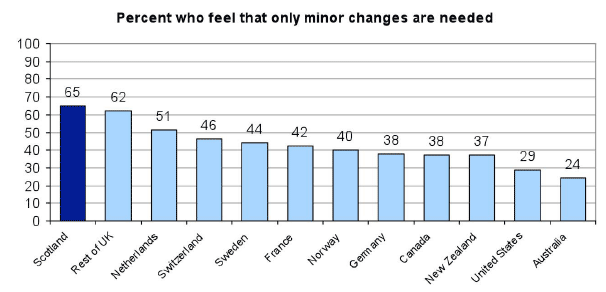
2010 Commonwealth Fund International Health Policy Survey - Access
13.6 In Scotland 67 per cent of patients were able to get a same or next day appointment when they were sick or needed care. This was significantly higher than in USA, Sweden Norway and Canada, but significantly lower than in Switzerland and New Zealand (Chart 16).
Chart 16: Access to doctor or nurse when sick or needed care
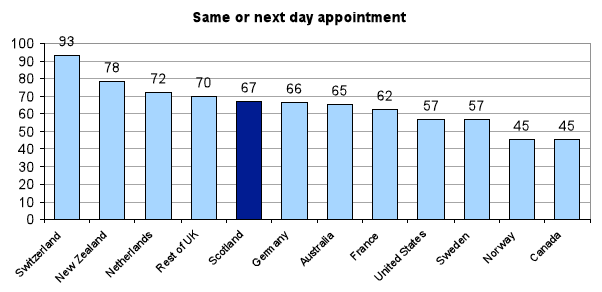
13.7 In Scotland 84 per cent of patients reported it was very or somewhat easy to contact their doctor by phone during regular hours. This was significantly higher than in Australia, Sweden, Canada and Norway, but significantly lower than in the Switzerland (Chart 17).
Chart 17 Easy to contact doctor by phone during regular hours15
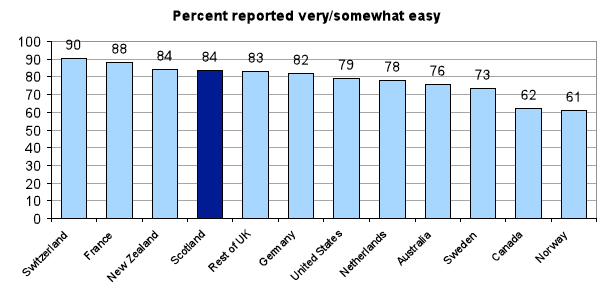
2010 Commonwealth Fund International Health Policy Survey - Doctors
13.8 From Table 19 it can be seen that Scotland performs well for the five questions on the patient experience of doctor communication. No country has a significantly better result for any of these questions compared to Scotland.
Table 19: Doctor patient communication16
| Percent reporting doctor always/often | |||||
|---|---|---|---|---|---|
| Country | Knows important information about medical history | Gives opportunity to ask questions about recommended treatment | Spends enough time with you | Involves you as much as you want in care decisions | Explains things in a way that is easy to understand |
| Australia | 87 | 88 | 85 | 86 | 91 |
| Canada | 84 | 85 | 80 | 83 | 89 |
| New Zealand | 93 | 92 | 90 | 92 | 92 |
| United States | 85 | 86 | 82 | 86 | 89 |
| Germany | 92 | 91 | 91 | 84 | 94 |
| Netherlands | 88 | 87 | 89 | 81 | 93 |
| France | 84 | 83 | 85 | 82 | 89 |
| Norway | 75 | 77 | 76 | 80 | 86 |
| Sweden | 57 | 65 | 67 | 62 | 74 |
| Switzerland | 89 | 92 | 90 | 85 | 94 |
| Rest of UK | 89 | 91 | 88 | 90 | 89 |
| Scotland | 90 | 93 | 88 | 91 | 92 |
13.9 In Scotland 16 percent of patients reported a coordination problem17 in the past two years. This was significantly lower than in Sweden, New Zealand, Switzerland, France, Canada, Australia, Germany, Norway and United States (Chart 18).
Chart 18: Coordination problems
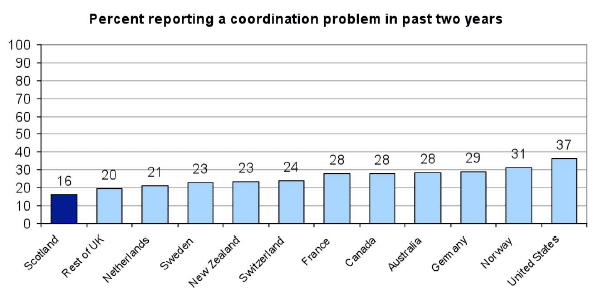
13.10 In Scotland 28 percent of patients reported experiencing inefficient or wasteful care in the past two years. This was significantly lower than in New Zealand, Switzerland, United States, France, Germany, Norway, Australia and Canada (Chart 19).
Chart 19: Perception of inefficient or wasteful care18
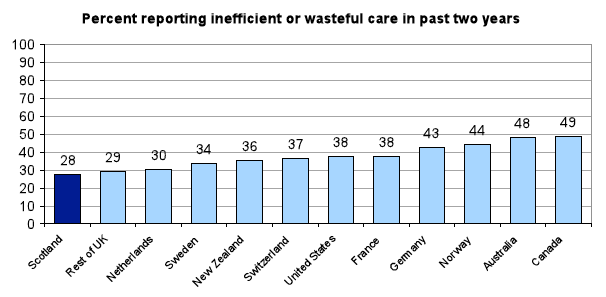
13.11 In Scotland 67 per cent of patients reported a problem with their prescription drugs in the past two years19. This was significantly lower than in Germany, Sweden, Switzerland, France, Norway and Netherlands but significantly higher than in the Australia (Chart 20).
Chart 20: Problems with prescription drugs in past two years
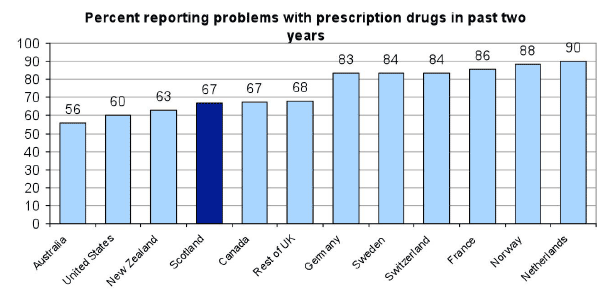
13.12 In Scotland 6 per cent of patients reported a medical, medication or lab test error in the past two years20. This was significantly lower than in all other countries apart from Germany and the rest of the UK (Chart 21).
Chart 21: Medical, medication or lab test errors
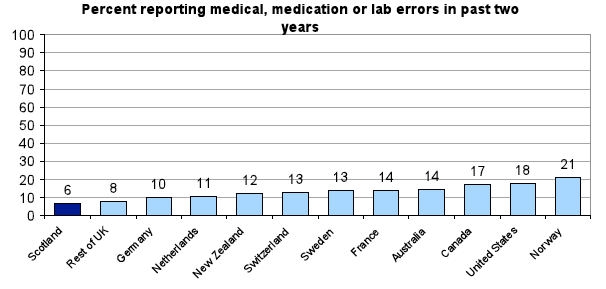
13.13 In Scotland 44 per cent of patients reported it was very or somewhat difficult to get out-of-hours care without going to A&E. This was significantly lower than in Germany, Australia, France, United States, Canada and Sweden, but significantly higher than in the Netherlands (Chart 22).
Chart 22: Difficulty getting out-of-hours care without going to A&E
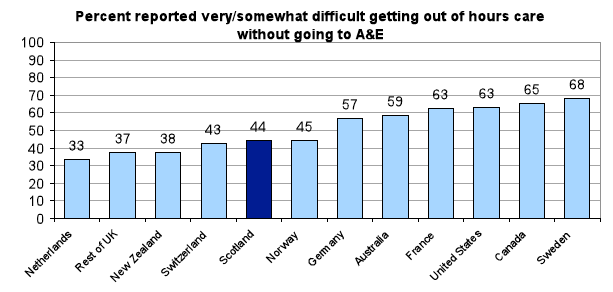
Contact
Email: Gregor Boyd
There is a problem
Thanks for your feedback